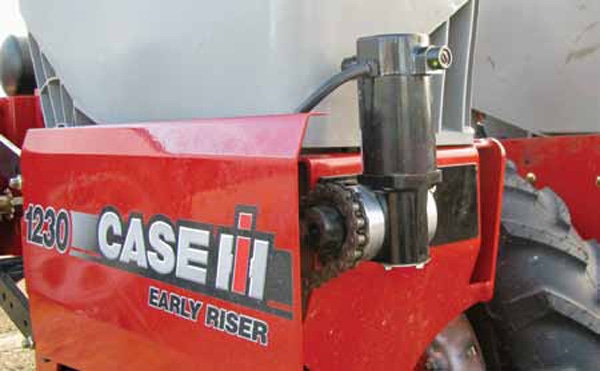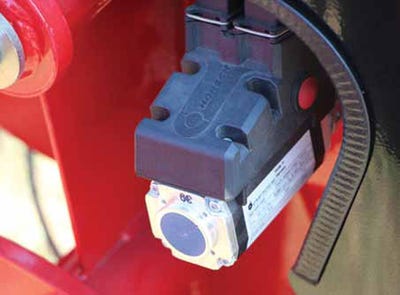January 6, 2014

Planters continue to get more precise. The latest upgrade is the use of electric motors to drive the seed meters in place of hydraulic- or ground-driven meters.
Toby Graham, Graham Equipment, started selling electric-drive kits for planters in 2011 after designing one for his father’s Monosem twin-row planter. Graham says in the short time he has offered electric-motor drives, they’ve gone from “gee whiz” gadgets to an accepted and sought-after investment
“It used to be that customers would come up to my booth and ask, ‘does it work?’,” Graham says. “Now, they say, ‘I’ve seen my neighbors use this, and what will it take to make it work on my farm?’”
Growing market
Since 2011, when Graham stepped into this market, several other companies now market electric planter drives. Kinze offers them as an option on its new 4900 series planter. Horsch has made the meters standard equipment on its Maestro planters. You also can buy after-market kits from companies including Graham Equipment and Precision Planting that allow you to upgrade your existing planter. Kits can cost around $1,000 to $1,200 per row, on average, depending on options.
Like what you’re reading? Subscribe to Farm Industry News Now e-newsletter to get the latest news and more straight to your inbox twice weekly.
Benefits of system
Companies that offer electric motor driven seed meters say they offer multiple benefits compared to traditional drive systems. “Electric drives simplify maintenance as there are no longer drive chains, sprockets or clutches to maintain,” says Drew Gerber, spokesperson for Horsch. “They also offer precise population control with an instantaneous response time on headlands, population changes within a field or planter speed changes.”
“Electric drives will also allow individual row control as well as curve compensation, ensuring your seed population is exactly what was prescribed, maximizing the productivity of every acre,” Gerber adds.
Graham says customers who have bought the drives have gotten full payback after two to three years due to the yield gains brought by better seed placement.
Because of these benefits, companies that make the meters say they will be standard equipment on planters in five years.
How they work.
All of the brands work from the same premise. A small electric motor, installed on each row unit of the planter, drives each seed meter, The precision metering makes it possible to control the seeding rates of individual rows and stop seeding where you don’t want to plant, all on the go. Power comes from a battery or alternator on the tractor or implement. Differences come in the power requirements of each motor and how that power is supplied.
Buyer’s Guide:
Here is a look at four different systems to provide you with a framework on how these systems work should you decide to buy.
Graham Equipment
Graham Equipment sells electric planter drive (EPD) kits for any planter make or model. The system uses direct-current brush motors that draw an average of 3 amps to drive each row unit. A tractor’s alternator typically has the capacity to power the motors on planters up to 16 rows. On larger planters, Graham offers a planter-mounted hydraulic auxiliary alternator. Motors are directly mounted to the seed plate, or mounted remotely with a chain drive to the seed plate. One EPD kit contains four motors (for a 16-row planter), a planter-mounted control board, a weatherproof harness, and an in-cab interface box that communicates wirelessly with the control board. Call 303/885-7428, or visit grahamelectricplanter.com.
Horsch

Horsch features electric motors as standard on its Maestro planter.
German planter manufacturer Horsch offers electric-motor-driven seed meters as standard equipment on its Maestro planter. Each planter row unit comes with a 12-volt brushless, direct drive motor that drives the seed meter. The electric-driven metering units place seed evenly and precisely in the row at speeds 20 to 40 percent faster than traditional planters, the company says.
Horsch says a key part of its system is that energy consumption per row is low, allowing the tractor to provide all the power necessary to drive each metering unit. Visit www.horsch.com.
Kinze
Kinze offers electric-motor-driven seed meters on its new 4900 Series planter. Each unit requires a high torque 24V motor that is powered by a separate alternator and hydraulic circuit on the planter. Kinze says the motors offer 99%+ accuracy at speeds from 2 and 8 mph when used in conjunction with its new 4000-series seed meters. Motors are fully sealed to keep out dust and water and can resist pressure washing. Contact drive also is available on this planter. Visit kinze.com.
Precision Planting
Precision Planting’s electric drive system is called the vDrive, and it is designed to work only with Precision Planting’s 20/20 SeedSense monitor and vSet meters. The company says vDrive is a low-current, 12-volt system that uses the tractor's battery and alternator for power Electrical requirements for vDrive is 1.25 Amps per row. An alternator is available to supplement power on larger planters. For 2014, the system will support John Deere, Kinze and CNH planters with 1.6 bushel hoppers and mini hoppers. The motor assembly is dust- and moisture-sealed and includes an encoder. Visit precisionplanting.com.
What’s next for electric drives?
Electric motor driven seed meters will open the door for other capabilities, beyond seed rate control, in the future. For example, Graham Equipment is using its electric motors to drive insecticide units simultaneously. “We are using our motors on dry fertilizer carts too,” says Toby Graham, Graham Equipment. Varying seed hybrids will be the next application, as demonstrated by the concept multi-hybrid planter being worked on by Raven Industries and South Dakota State University. Multiple hybrid technology is also currently under development by Horsch.
About the Author(s)
You May Also Like




